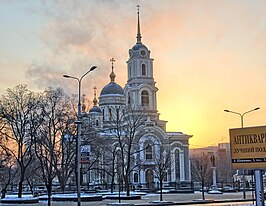
Back Donetsk Afrikaans Donetsk AN Hughesofka ANG دونيتسك Arabic دونييتسك ARZ Donetsk AST Donetsk AVK Donetsk Azerbaijani دونتسک AZB Донецк Bashkir
Donetsk
| |
|---|---|
City | |
| Ukrainian transcription(s) | |
| • Romanization | Donetsk |
| • Scholarly | Donećk |
Left to right from top: Transfiguration Cathedral (big image); Donbass Palace; Drama Theatre; Lenin Square; Opera Theatre; and bridge on Ilicha Prospect | |
| Coordinates: 48°00′10″N 37°48′19″E / 48.00278°N 37.80528°E | |
| Country | Ukraine (occupied by Russia) |
| Oblast | Donetsk Oblast |
| Raion | Donetsk Raion |
| Hromada | Donetsk urban hromada |
| Founded | 1869[1] |
| City rights | 1917 |
| Districts | |
| Government | |
| • Mayor | Alexey Kulemzin (installed by Russia; United Russia) |
| Area | |
• City | 358 km2 (138 sq mi) |
| • Metro | 2,895 km2 (1,118 sq mi) |
| Elevation | 169 m (554 ft) |
| Population (2022) | |
• City | 901,645 |
| • Density | 2,500/km2 (6,500/sq mi) |
| • Metro | 1,560,000 |
| Demonym | Donechchany (Ukrainian: Донечча́ни) or Donchane (Russian: Донча́не) |
| Time zone | UTC+2 (EET) |
| • Summer (DST) | UTC+3 (EEST) |
| Postal code | 83000–83497 |
| Area code(s) | +380 622, 623 |
| Licence plate | АН |
| Sister cities | Bochum, Charleroi, Kutaisi, Pittsburgh, Sheffield, Taranto, Moscow, Vilnius |
| Climate | Dfb |
| Website | donetsk |
 | |
| ^ Donetsk was founded in 1869 as a workers' settlement Yuzovka/Yuzivka around the metallurgical factory of the Welshman John Hughes. The settlement was established in lands of Yevdokim Shydlovsky, who received them upon destruction of the Zaporizhian Sich in 1775. ^ The population of the metropolitan area is from 2004. | |
Donetsk (UK: /dɒnˈjɛtsk/ don-YETSK,[1] US: /dən-/ dən-;[2][3] Ukrainian: Донецьк [doˈnɛtsʲk] ⓘ; Russian: Донецк [dɐˈnʲetsk] ⓘ), formerly known as Aleksandrovka, Yuzivka (or Hughesovka), Stalin, and Stalino, is an industrial city in eastern Ukraine located on the Kalmius River in Donetsk Oblast, which is currently occupied by Russia as the capital of the Donetsk People's Republic. The population was estimated at 901,645 (2022 estimate)[4] in the city core, with over 2 million in the metropolitan area (2011). According to the 2001 census, Donetsk was the fifth-largest city in Ukraine.[5]
Administratively, Donetsk has been the centre of Donetsk Oblast, while historically, it is the unofficial capital and largest city of the larger economic and cultural Donets Basin (Donbas) region. Donetsk is adjacent to another major city, Makiivka, and along with other surrounding cities forms a major urban sprawl and conurbation in the region. Donetsk has been a major economic, industrial and scientific centre of Ukraine with a high concentration of heavy industries and a skilled workforce. The density of heavy industries (predominantly steel production, chemical industry, and coal mining) determined the city's challenging ecological situation. In 2012, a UN report ranked Donetsk among the world's fastest depopulating cities.[6]
The original settlement in the south of the European part of the Russian Empire was first mentioned as Aleksandrovka in 1779, during the reign of the Empress Catherine the Great. In 1869, the Welsh businessman John Hughes founded a steel plant and several coal mines in the region, and the town was named Hughesovka or Yuzovka (Юзовка) in recognition of his role ("Yuz" being a Russian-language approximation of Hughes). During Soviet times, the city's steel industry expanded. In 1924, Yuzovka was renamed Stalin. In 1929, Stalin was renamed Stalino, and in 1932, the city became the centre of the Donetsk region. Renamed Donetsk in 1961, the city today remains a centre for coal mining and for the steel industry.
Since April 2014, Donetsk and its surrounding areas have been one of the major sites of fighting in the ongoing Russo-Ukrainian War, as pro-Russian separatist forces battle against Ukrainian military forces for control of the city and surrounding areas. Throughout the war, the city of Donetsk has been administered by the pro-Russian separatist forces as the center of the Donetsk People's Republic (DPR), with outlying territories of the Donetsk region divided between the two sides.[7] Donetsk International Airport became the epicenter of the war in 2014 with almost a year-long battle.
As of October 2022[update], Russia has full control of the city,[8] with Ukrainian and Russian forces still in combat near the city.
- ^ "Donetsk". Lexico UK English Dictionary. Oxford University Press. Archived from the original on 3 February 2020.
- ^ "Donetsk". The American Heritage Dictionary of the English Language (5th ed.). HarperCollins. Retrieved 5 September 2019.
- ^ "Donetsk". Merriam-Webster.com Dictionary. Merriam-Webster. Retrieved 5 September 2019.
- ^ Чисельність наявного населення України на 1 січня 2022 [Number of Present Population of Ukraine, as of January 1, 2022] (PDF) (in Ukrainian and English). Kyiv: State Statistics Service of Ukraine. Archived (PDF) from the original on 4 July 2022.
- ^ "Results / General results of the census / Number of cities". 2001 Ukrainian Census. Archived from the original on 9 January 2006. Retrieved 28 August 2006.
- ^ The 28 Fastest-Shrinking Cities In The World
- ^ Weaver, Matthew; Luhn, Alec (13 February 2015). "Ukraine ceasefire deal agreed at Minsk talks". The Guardian. Retrieved 16 December 2016.
- ^ Barros, George; Stepanenko, Kateryna; Bergeron, Thomas (30 September 2022). "Interactive Map: Russia's Invasion of Ukraine". ArcGIS StoryMaps. Institute for the Study of War and Critical Threats. Retrieved 1 October 2022.










